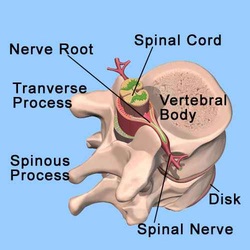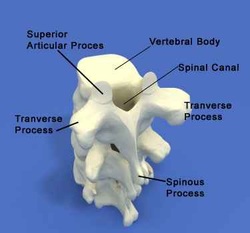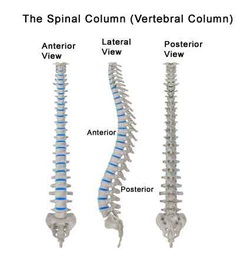In my thought process chiro's would be your best ref. when it comes to being a trainer, because they know the importance of a stronge back.
Why Do Back Exercises? Note: If you have a back injury or current back pain read: Post-injury exercise page first.
Weak Muscles Increase the Risk of Back Pain Weak muscles are often at the root of back pain, especially lower back pain. The muscles of the back, the abdomen, and the buttocks all support the spine - these muscles are called the core muscles.
Muscles are the spine's main defense against gravity. Strengthening the muscles that support the spine with exercises, can prevent, reduce and in some cases eliminate back pain.
Strong abdominal muscles (especially the deep abs) are as crucial as strong back muscles for supporting the lower back and preventing lower back pain. Strong quadriceps (front of thigh muscles) is important to prevent back injuries when lifting. Proper lifting techniques involve using your legs and if your legs are weak, you may end up using your back.
Shortened Muscles Cause Back Pain Shortened muscles can throw the spine out of alignment and cause back pain. Stretching exercises lengthen shortened muscles and relieve back pain. Tight back muscles, tight buttocks muscles, tight muscles in the front of the hip and even tight quadriceps (front of thigh muscles) or tight hamstrings (back of thigh muscles) can affect the alignment of the spine. Stretching the back with stretching exercises also increases mobility of the joints of the spine.
Strong and flexible muscles help maintain Proper Posture and prevent Back Strain.
Check with your physician before doing back exercises if you have back pain, a back condition or other medical condition. Warm up the muscles with 5 minutes of light aerobics such as walking or riding a stationary bike before either stretching or strengthening exercises to reduce the risk of injury.
Stretching or Strengthening Exercises First? Stretching after strengthening exercises helps relieve the muscle tightness that can occur from strengthening exercises and may be more beneficial that stretching before strengthening exercise. However it is largely a matter of personal preference - stretching and strengthening exercises can also each be done on separate days if desired. Remember to warm up first.
Do Not hold your breath! Holding your breath can cause a spike in blood pressure! Concentrate on breathing while exercising.
Back Anatomy The Spinal Column: The spinal column (also called the vertebral column) contains and protects the spinal cord and supports the body and head. The spinal column is flexible to allow movement of the body.
The spinal column is comprised of a column of small bones called vertebrae.
Shock absorbing discs separate the vertebrae.
Vertebrae:
The 24 vertebrae are named according to their location along the spine. We start out with 33 vertebrae but the lowest nine fuse together to form single bones- 5 fused vertebrae form the sacrum and 4 tiny fused vertebrae form the coccyx (tailbone).
The 24 True or Movable Vertebrae: Cervical spine (neck area) with 7 vertebrae (labeled C1 - C7)
Thoracic spine (chest area) with 12 vertebrae (labeled T1 - T12)
Lumbar spine (lower back) with 5 vertebrae (labeled L1 - L5)
Fused Vertebrae (Below the lumbar spine):
Sacrum: a triangular shaped solid base with 5 fused vertebrae - connects with the pelvis
Coccyx: (the tailbone) with 4 very small fused vertebrae.
Why Do Back Exercises? Note: If you have a back injury or current back pain read: Post-injury exercise page first.
Weak Muscles Increase the Risk of Back Pain Weak muscles are often at the root of back pain, especially lower back pain. The muscles of the back, the abdomen, and the buttocks all support the spine - these muscles are called the core muscles.
Muscles are the spine's main defense against gravity. Strengthening the muscles that support the spine with exercises, can prevent, reduce and in some cases eliminate back pain.
Strong abdominal muscles (especially the deep abs) are as crucial as strong back muscles for supporting the lower back and preventing lower back pain. Strong quadriceps (front of thigh muscles) is important to prevent back injuries when lifting. Proper lifting techniques involve using your legs and if your legs are weak, you may end up using your back.
Shortened Muscles Cause Back Pain Shortened muscles can throw the spine out of alignment and cause back pain. Stretching exercises lengthen shortened muscles and relieve back pain. Tight back muscles, tight buttocks muscles, tight muscles in the front of the hip and even tight quadriceps (front of thigh muscles) or tight hamstrings (back of thigh muscles) can affect the alignment of the spine. Stretching the back with stretching exercises also increases mobility of the joints of the spine.
Strong and flexible muscles help maintain Proper Posture and prevent Back Strain.
Check with your physician before doing back exercises if you have back pain, a back condition or other medical condition. Warm up the muscles with 5 minutes of light aerobics such as walking or riding a stationary bike before either stretching or strengthening exercises to reduce the risk of injury.
Stretching or Strengthening Exercises First? Stretching after strengthening exercises helps relieve the muscle tightness that can occur from strengthening exercises and may be more beneficial that stretching before strengthening exercise. However it is largely a matter of personal preference - stretching and strengthening exercises can also each be done on separate days if desired. Remember to warm up first.
Do Not hold your breath! Holding your breath can cause a spike in blood pressure! Concentrate on breathing while exercising.
Back Anatomy The Spinal Column: The spinal column (also called the vertebral column) contains and protects the spinal cord and supports the body and head. The spinal column is flexible to allow movement of the body.
The spinal column is comprised of a column of small bones called vertebrae.
Shock absorbing discs separate the vertebrae.
Vertebrae:
The 24 vertebrae are named according to their location along the spine. We start out with 33 vertebrae but the lowest nine fuse together to form single bones- 5 fused vertebrae form the sacrum and 4 tiny fused vertebrae form the coccyx (tailbone).
The 24 True or Movable Vertebrae: Cervical spine (neck area) with 7 vertebrae (labeled C1 - C7)
Thoracic spine (chest area) with 12 vertebrae (labeled T1 - T12)
Lumbar spine (lower back) with 5 vertebrae (labeled L1 - L5)
Fused Vertebrae (Below the lumbar spine):
Sacrum: a triangular shaped solid base with 5 fused vertebrae - connects with the pelvis
Coccyx: (the tailbone) with 4 very small fused vertebrae.




